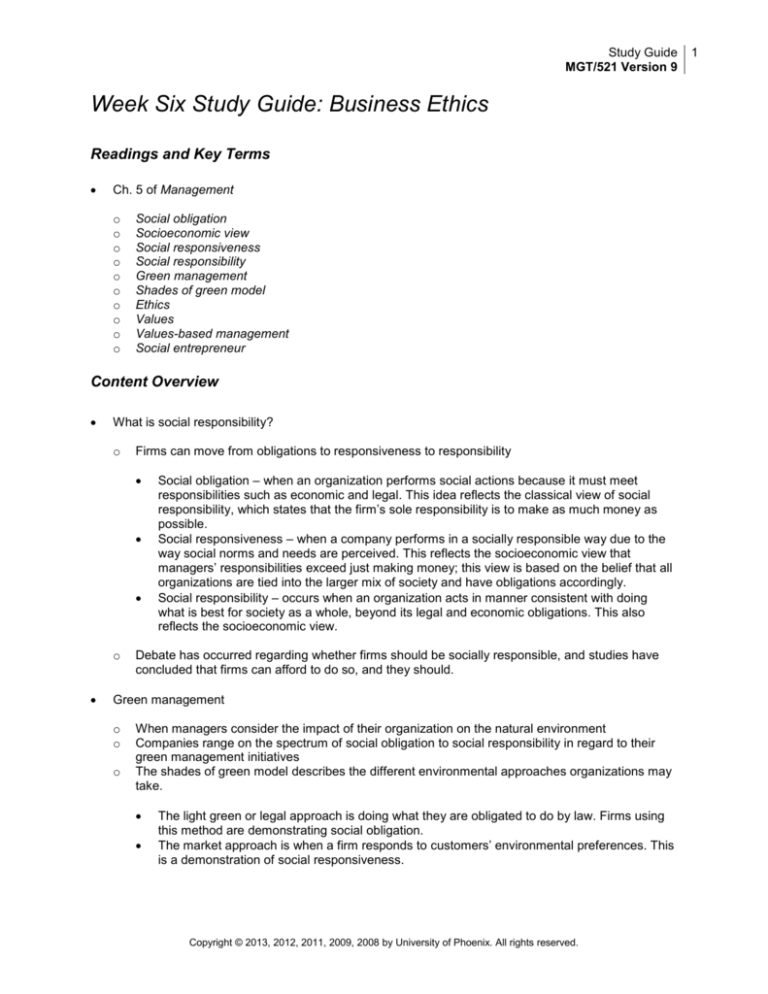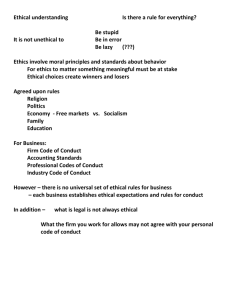
Study Guide
MGT/521 Version 9
Week Six Study Guide: Business Ethics
Readings and Key Terms
Ch. 5 of Management
o
o
o
o
o
o
o
o
o
o
Social obligation
Socioeconomic view
Social responsiveness
Social responsibility
Green management
Shades of green model
Ethics
Values
Values-based management
Social entrepreneur
Content Overview
What is social responsibility?
o
Firms can move from obligations to responsiveness to responsibility
o
Social obligation – when an organization performs social actions because it must meet
responsibilities such as economic and legal. This idea reflects the classical view of social
responsibility, which states that the firm’s sole responsibility is to make as much money as
possible.
Social responsiveness – when a company performs in a socially responsible way due to the
way social norms and needs are perceived. This reflects the socioeconomic view that
managers’ responsibilities exceed just making money; this view is based on the belief that all
organizations are tied into the larger mix of society and have obligations accordingly.
Social responsibility – occurs when an organization acts in manner consistent with doing
what is best for society as a whole, beyond its legal and economic obligations. This also
reflects the socioeconomic view.
Debate has occurred regarding whether firms should be socially responsible, and studies have
concluded that firms can afford to do so, and they should.
Green management
o
o
o
When managers consider the impact of their organization on the natural environment
Companies range on the spectrum of social obligation to social responsibility in regard to their
green management initiatives
The shades of green model describes the different environmental approaches organizations may
take.
The light green or legal approach is doing what they are obligated to do by law. Firms using
this method are demonstrating social obligation.
The market approach is when a firm responds to customers’ environmental preferences. This
is a demonstration of social responsiveness.
Copyright © 2013, 2012, 2011, 2009, 2008 by University of Phoenix. All rights reserved.
1
Study Guide
MGT/521 Version 9
The stakeholder approach also demonstrates social responsiveness, and in this approach, an
organization works to meet the environmental demands of multiple stakeholders, such as
employees, suppliers, and the community.
The dark green or activist approach is a type of social responsibility, and it looks for ways to
protect the earth’s natural resources. This is the highest degree of environmental sensitivity.
Organizations can show green management through pursuing standards developed by the
International Organization for Standardization.
Managers and ethical behavior
o Ethics
The “principles, values, and beliefs that define right and wrong decisions and behavior”
(Robbins & Coulter, 2012, p. 130).
Factors that determine ethical and unethical behavior:
o
o
o
o
o
Stage of moral development – behavior develops, becoming increasingly moral as
different stages are reached. As the stages progress, a person becomes increasingly
independent from outside influences.
Individual characteristics – values—basic convictions about what is right and wrong—
and personality play a role in determining whether a person behaves ethically.
Personality variables that influence an individual’s actions include ego strength and locus
of control.
Structural variables – organizational structures that minimize ambiguity and uncertainty
with formal rules and regulations and remind employees of these rules and regulations
are more likely to encourage ethical behavior. How goals are set can also influence
ethical or unethical behavior.
Organizational culture – an organizational culture that is high in risk tolerance, control,
and conflict tolerance can promote ethical behavior. Values-based management is where
the organization’s values guide employees in the way they do their jobs.
Issue intensity – the higher the intensity of the situation, the more likely it will be
perceived as unethical. (Robbins & Coulter, 2012, p. 132)
o Social and cultural differences
While some common moral beliefs exist, social and cultural differences between countries
and regions are important in determining what is considered ethical and unethical in each
area.
Managers in a multinational organization must determine whether employees in a specific
location adhere to their location’s ethical standards or the standards of the home office
location.
The Global Compact was created by the United Nations to set common standards of ethical
treatment “in the areas of human rights, labor, the environment, and anticorruption” (Robbins
& Coulter, 2012, p. 132).
o Encouraging ethical behavior
While managers can take steps to encourage ethical behavior, including creating
comprehensive ethics programs, this does not always mean that employees will act ethically.
Steps taken during the employee selection process may allow managers hiring new
employees to ascertain the values of candidates, in an attempt to find someone whose
values align with those of the company.
Creating a code of ethics—a formal statement, created by an organization, stating the values
it holds dear and to which it expects employees to adhere—can reduce ambiguity in ethical
Copyright © 2013, 2012, 2011, 2009, 2008 by University of Phoenix. All rights reserved.
2
Study Guide
MGT/521 Version 9
decision making for employees. Codes of ethics should set guidelines for ethical decisions
but be flexible enough to allow employees the freedom to adapt to the situation.
Top managers and leaders can encourage ethical behavior by acting ethically and serving as
good examples to their employees. Managers should also reward employees acting ethically
(and punish employees acting unethically), so this can serve as an example to other
employees.
Managers can also establish ethics training programs to encourage ethical behavior.
Although most values are learned in childhood, training can assist employees in polishing
their ideas about ethics.
Current issues in social responsibility and ethics
o
Managing ethical lapses and social irresponsibility—two managerial actions seem particularly
important in encouraging ethical behavior among employees:
o
Social entrepreneurship
o
Serving as a good example by promoting and exhibiting ethical leadership
Protecting employees who raise ethical issues and bringing these issues to management
Social entrepreneurs find ways to effect society in a positive, sustainable, innovative way
and they use creativity and ingenuity.
Promoting positive social change can be done through two main ways:
Corporate philanthropy – where organizations support social causes, through investing
time, money, and other resources
Encouraging employees to volunteer their time and efforts for change
Copyright © 2013, 2012, 2011, 2009, 2008 by University of Phoenix. All rights reserved.
3








